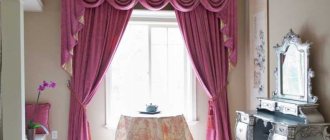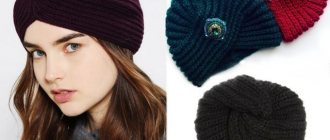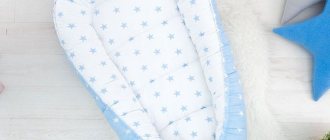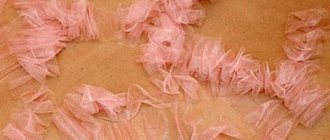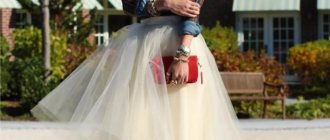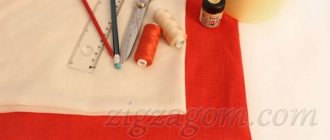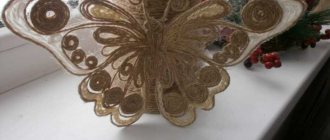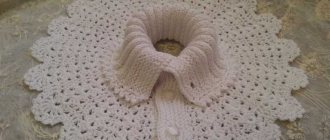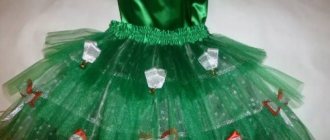Elegant headdress - turban
If you haven’t had time to do a beautiful hairstyle, but you want to look fashionable and elegant, put an elegant turban on your head.
The turban became fashionable among Europeans back in the 40s and remains very popular to this day. This headdress is loved because it makes it possible to create a feminine, charming image.
An oriental outfit looks equally beautiful with a coat or with long chiffon dresses or pantsuits made of shiny or matte silk.
At the most difficult moment, a bandage made from a scarf will help out.
You can simply wrap the scarf around your head and then pin it with a brooch. But this is not a reliable structure; it is better to sew it yourself.
To sew a turban, all you need is a little time and a piece of plastic fabric.
The craftswomen learned how to sew a fashion accessory from a T-shirt, which was quite boring.
- Take a piece of fabric and fold it in half to make a rectangle measuring 60 by 30 cm.
- Round the edges at the top. If this is a piece from a T-shirt, then the hemmed edge will become the bottom of the product!
- Baste face inward, leaving the bottom edge.
- Machine sew the top and sides of the future product.
- Without removing the product from under the machine foot, pull the thread slightly, making the top and side sections gathered.
- Turn the product inside out, put it on a mannequin, if there is none, then on a three-liter jar.
- Grab the fabric from both sides, connect in the middle.
- Seal with stitches.
- Next, grab the material below to create a fold, and also secure with stitches.
- Make another group of folds and secure with thread.
- Cut off the remaining fabric, leaving 2 cm for the hem.
- Wrap the “tail” in folds and sew it onto your hands.
- Turn it inside out and place it over the can to create a gather at the back of the head.
- Try on the finished turban!
You can also watch a video on how to sew a turban from knitwear:
What fabric is used to sew a turban?
Initially, a turban is not a ready-made headdress, but strips of fabric wrapped using a special method. The finished design was worn on a hat or scarf. This was done in order to avoid slipping off the head and to give the headdress a more voluminous look. Currently, the turban manufacturing scheme has been slightly modernized - now it is not twisted, but sewn.
To make a truly high-quality product, you need not only to find a step-by-step master class on the Internet on how to pattern a turban, but also to decide on the material from which it will be made. As a rule, brocade or silk is used for tailoring, but in general, any fabric can be used, provided that it is flexible and drapes well.
Brocade turban
An original accessory with an oriental flavor can be sewn from the following types of fabrics:
- Silk and chiffon - as a rule, stylish and bright hats are made from these materials.
- Viscose and cotton are used if you need to sew a turban to wear on the beach or in nature in hot weather.
- Cashmere or velvet are used when you need to get an autumn accessory.
- Brocade - this fabric is used to make a bright and elegant headdress.
You might be interested in this. Master classes for sewing different models of dresses on your own.
Chiffon turban
If desired, a turban can be worn even in winter. To do this, it is made from natural or artificial fur. You definitely shouldn’t take thick and coarse fabrics, as the headdress made from them will be completely inelastic. In general, the most versatile option would be knitwear. You can use it to make a summer, autumn and winter turban, or make a children's turban for matinees or masquerades. But this material must also be of high quality.
Turban made of knitted fabric
Additional Information! The most successful turban colors for women are black, sand, gray and wine.
Knitted turban with brooch
We make a turban from knitwear. Choose a chunky knit for a truly warm beanie. This season, the most fashionable colors will be blue, chocolate, rich brown and gray.
You will need:
- knitted fabric, 20-25 cm wide;
- threads, needle, brooch for decoration.
The pattern is the simplest, as in the first case - a rectangle. Also fold the fabric in half, sew the side seams, and decorate the center of the product with a beautiful brooch. Next, proceed according to the scheme described above.
Fashion trends
Like any stylish accessory, the turban hat changes with each new season. These innovations relate to style, color, material and decorative elements. This season, the trend is strict forms - the turban is more miniature, characterized by a minimal number of lines. Scarves fade into the background, giving way to hats and headbands.
European style suppresses the oriental one: supple fabrics that are soft to the touch, minimal decor.
Rich shades are in fashion (for example, purple or fuchsia); you should choose the appropriate option based on your own color type. However, the eternal classics - black and white - are still in trend and will suit many fashionistas. Gray is also ideal for an updated, softer look. The favorite is a fashionable wine shade (which suits almost everyone), it is beautiful on its own, as well as in combination with other tones. This is not the first year that emerald has been popular. The knitted turban will also be decorated with various shades of pink, beige and peach. The basic sand color can adapt to any woman's wardrobe.
This is interesting: What Happened to Sobchak’s Son
Decor plays an important role in a modern headdress; it is especially relevant for an evening look. A classic decoration is a massive brooch, smooth or with a scattering of stones. A fashionable turban today is also decorated over the entire surface with sequins or beads. A mesh veil on a headdress will add mystery and piquancy to the lady - an excellent evening option. However, it should be kept in mind that when choosing a turban with decoration, you do not need to wear other flashy decorations, since this is already a self-sufficient detail that attracts attention.
Is there a difference between a turban and a turban?
A turban is often called a turban.
A turban is also a headdress made from a sheet of fabric that is wrapped around the head several times. Such accessories are worn by the peoples of India, North Africa, and Asia.
To make a turban, they take 6-8 meters of fabric, sometimes even 20 meters of brocade, velvet, and cashmere. Mandatory decoration are brooches and strings of pearls.
In India, the cloth was soaked in water and then wrapped around the head to keep it cool all day. This is how they escaped the scorching sun.
Today you can see girls wearing a turban, hiding their heads from the sun or walking around the city in it.
Some fashionistas wrap pieces of fabric in different colors to create a fashionable look.
Indian men still decorate their heads with this intricate design.
A turban is much smaller than a turban. Initially, only the stronger half wore it, then the girls adapted it to suit themselves.
There are several ways to create this accessory. Each eastern people has its own way of tying this hat.
How to wrap a turban:
- Take a long strip of material.
- Take one end in your teeth (so that your hands are free), stretch the other diagonally.
- Wrap it around your head at an angle, gradually covering open areas.
- Continue this process until a small tip remains of the fabric.
- Tuck it under the fabric and secure with a brooch.
The next method is from a scarf.
- Take a long scarf and cover your head.
- Throw one end over the other at the back of your head.
- At the front, tie them on the forehead with a strong knot.
- Next, wrap one end into a loop and pass through a loose knot.
- Thread the other end through the loop, then do not pull too hard on the ends of the scarf.
- Tuck the ends under the structure itself.
- Instead of a knot, you can cross the ends of the scarf on your forehead, make a loop, and pass the other end of the scarf through it to form a second loop.
- Tighten the loops tightly again to prevent the structure from falling apart.
- Hide the ends.
Peculiarities
Turban is a traditional headdress for men in many eastern countries.
This thing is a narrow and long piece of fabric that wraps around the head more than once. As a rule, it is worn on top of a skullcap, although Indians and Pakistanis wear the headdress directly on their bare heads.
Each nationality is characterized by a certain color scheme, size and material of the turban, and the options for tying it also differ. Even within the same country, this headdress is not the same - it denotes a person’s social affiliation. Thus, Muslims traditionally wear a white turban, but anyone who has visited Mecca at least once or belongs to the family of the great prophet has the right to wear a green or black headdress.
Researchers of oriental life and culture have found that there are at least a thousand options for wearing a turban. It is interesting that in the Middle Ages it was customary to hide a tulip in its folds - a flower, according to legend, that brings good luck.
The turban perfectly protects desert inhabitants from the rays of the scorching sun, and in battle it protects the head from injury and, moreover, simply adds height to a man.
Of course, over many centuries, some types of oriental costume have lost their former relevance. So, today the turban perfectly complements a strict business suit - Arab political leaders wear it during trips abroad, as well as meetings within their country.
This headdress is often mistakenly identified with a turban. However, the turban, unlike it, has a lower edge that is not straight. And besides, it is much smaller in size.
Gradually, the turban became part of the women's wardrobe. Made from expensive material and precious stones, this item perfectly emphasizes the beauty of oriental beauties.
This is interesting: Menopause in Women Symptoms
From the East, this accessory came into European fashion. Throughout the 20th century, it appeared and disappeared from the stylish wardrobe. For example, post-war women began to wear turbans, wanting to dilute their lives with an element of luxury.
In recent years, this accessory has been back in fashion and is not going to give up its leadership position. And for the convenience of fashionistas, a hat was invented that outwardly copies the shape of a turban - there is no need to waste time tying it. This headdress can be worn in all seasons; it is very popular even in warm weather.
One of the varieties of the accessory is a headband similar to a turban - a more primitive option that protects the ears from gusts of wind.
Speaking about the features of this headdress, which distinguishes it favorably from other options, we note the unique oriental style (after all, most modern hats are somewhat similar to each other). In addition, the turban has variations: you can put a ready-made hat or headband on your head, or you can effectively wrap a long scarf or scarf.
This accessory is also beneficial because it is appropriate with many types of outerwear. It is practical - it will hide a bad hairstyle or lack of styling. The turban is suitable for women of all ages: it will decorate both a young girl and a respectable lady of elegant age.
